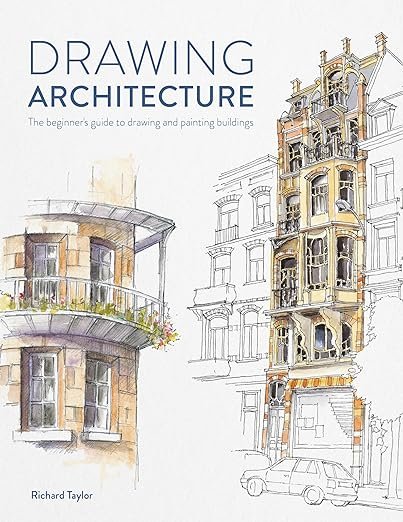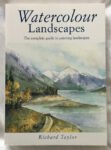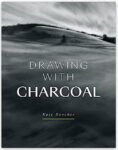It’s been a busy day as I’ve been making notes on this book that I finished reading yesterday and am now ready to write up a review. Landscape Artist Of The Year always seems to be building focused, so I’ve been wanting for a while to read a book on painting buildings. And, with the Jonathan Newey book being seemingly out of print, this seemed the best option on the market. The pages I could preview on Amazon looked good with a bit of text and a drawing with lots of arrows pointing to different places with little tips. This one is a 120 page paperback – maybe a little short but let’s see what’s in there.
So we have four chapters. Roughly 20 pages on introduction and materials, 20 pages on “mechanics”, 60 pages on specific types of building and 15 pages on “the bigger picture”. Let’s go through chapter by chapter.
We start with materials. The emphasis of this book is on drawing rather than painting (which I knew), so this is mainly about pencils and powdered graphite, although watercolour gets a mention too. And there’s talk of line and wash, where Richard prefers to use non–waterproof inks so he cam smudge and spread the lines. That’s a bit unusual. But this chapter’s not just about materials. There are drawings and paintings throughout the chapter with arrows and tips.
We then get a chapter on “mechanics” which covers all sorts of stuff. We get a brief introduction to one, two and three point perspective. I didn’t need lots of detail in this but beginners might need more than Richard discusses here and I’m sure there are books out there for them if that’s the case. There’s also some stuff on composition including some interesting thoughts on what to do about foregrounds when it’s the building in the middleground that’s the focus. And then, before we get onto buildings, there are tips on drawing bricks, stones, wood and tiles. It’s good, by the way, to see that Richard’s most used colours in this book are raw sienna, burnt sienna, burnt umber and French ultramarine, four of my first choice squad. Less good is how he gets the browns mixed up in places, putting the wrong labels on swatches.
We then get to to the big chapter on buildings. It’s divided into five subchapters on rural buildings, urban buildings, classical architecture, public buildings and street architecture. Richard talks through all the different sorts of buildings, giving lots of tips in both the main body of the text and on arrows pointing to his buildings. And this is where I started switching off. This chapter would be fine if I kept getting fed new tips but it seems that there is a bottom to Richard’s tip bucket because after a while the same old tips kept coming back. There’s only so many times I can be told to not treat the application of paint as a colouring in exercise, to get the shadows round doors and windows right and to put both dark shapes and reflections in windows. I guess there are still lots of drawings to look at but they all tend to be in the same three or four styles.
And finally there’s a chapter on “the big picture”, which I thought was going to be one of those “bringing it all together” chapters that teach the reader nothing. But, no, it turned out to be about bigger pictures! Tips on how to combine together lots of photos into one big photo to paint, which was interesting.
I can’t help feeling a bit short changed at the end. The book is only 120 pages long and, with so much repetition, felt more like three copies of a 40 page book or four copies of a 30 pager. There are some useful tips and it got me thinking in places, but it did feel like a tin of chocolates that was only half full with lots of cardboard filling up the rest of the space. I’m an experienced artist but even if I was a beginner I’d probably feel a little cheated. While I wouldn’t buy this one again if my studio burnt down, it’s not so bad that I feel angry and conned. So that makes it worth two palettes.
🎨🎨









Leave a Reply